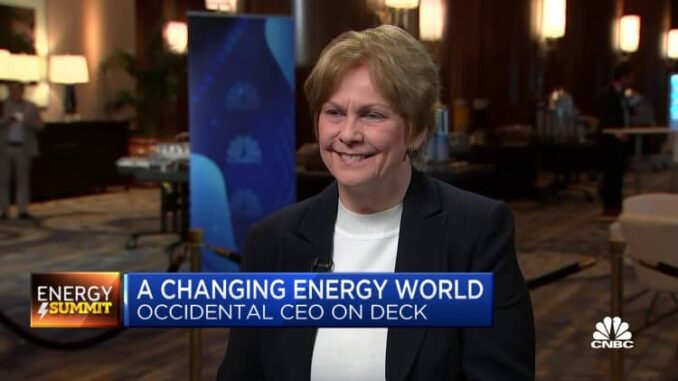
- Oxy CEO Vicki Hollub oversaw the No. 1-performing stock in the S&P 500 in 2022.
- The White House has pressured oil companies to produce more but Hollub says its capital spending plan will remain as focused on buybacks and dividends as oil production.
- She also says the current oil price range of $75-$80 is here to stay for the next few years, with modest upside risk to prices.
Occidental (long known as Occidental Petroleum) was the No. 1-performing stock in S&P 500 last year, but it didn’t get there by way of massive growth in oil and gas production. While fossil fuels have the tailwind of the Russia-Ukraine war resetting energy policy and priorities around the globe, on Wall Street, it’s the recent capital discipline displayed by energy companies that has been as a big a factor in market performance.
The boom and bust cycles of the past when oil rig count exploded in line with the latest high price in crude oil are now seen as a cautionary tale. “We’ve seen that movie before,” Hess CEO John Hess said at the annual CERAWeek energy conference on Tuesday. That new fiscal approach from the energy patch has not made the White House happy, especially when oil prices and oil company profits were at a peak last year. The blowback from President Biden has continued, with recent buyback programs from companies including Chevron attracting renewed scrutiny. But when you listen to the way Chevron CEO Mike Wirth talked about its plans to increase the level of buybacks for shareholders, it seems the White House was an afterthought — if any thought was given to it.
Long-time energy sector analyst Paul Sankey put it this way after the recent Chevron earnings call: “I would be absolutely certain many in the White House own Chevron stock in their 401ks. In DC, it is clear that politicians have no comprehension of 1) what a buyback is and 2) how many Americans own stocks in their pension funds/401ks. The tone of Mike’s delivery, and he is a relaxed and confident guy, indicated that they were not really considering Washington, D.C.”
Wirth isn’t the only one sitting in the driver’s seat at a major oil and gas company who seems to have little time to worry about the way the White House views stock buybacks.
Occidental’s approach has attracted the world’s most-famous investor, with the company quickly growing to be among the top 10 stocks held by Warren Buffett’s Berkshire Hathaway over the past several years (second to Chevron among Buffett’s public energy stock holdings). Buffett recently made clear (for the umpteenth time) what he thinks about politicians weighing in on buybacks.
With roughly 12% production growth, Occidental could produce more. And in fact, one point the White House has made is that oil companies are spending too much on “enriching” shareholders and not enough on producing more. But when asked by CNBC’s Brian Sullivan on Monday at CERAWeek if the company could produce more, Occidental CEO Vicki Hollub answered in a direct way that defies any concern about political pressure:
“We do,” Hollub said, have the ability to produce more oil, “but we have a value proposition that includes an active buyback program and also a growing dividend and we always want to make sure we max out our return on capital employed. So we are very careful with how we structure our capital program on an annual basis to make sure we still have sufficient cash to buy back shares.”
This year, Occidental authorized a new $3 billion share repurchase authorization and a 38% increase to its dividend. It completed $3 billion in share repurchases last year, with $562 million of repurchases in the fourth quarter.
“Look, we are a stronger company than we were a few years ago, so the numbers are bigger but the patterns are no different,” Chevron’s CEO Wirth told CERA chairman Daniel Yergin on Monday at the conference, referring to Chevron’s financial priorities – sustaining and growing its dividend, reinvesting capital to bring supplies to market (its budget is up 30% year over year), maintain a strong balance sheet for ups and downs in the commodities cycle, and returning excess cash to shareholders. “We could stack it up on the balance sheet,” Wirth said, but he added, “It’s their cash.”
“Some things get more scrutiny at certain points in time than others,” he told Yergin when asked multiple times about the political “heat.”
What to expect in gas prices at the pump
Frederick Forthuber, president of Oxy Energy Services, said separately at CERAWeek that U.S. oil production will grow by about 500,000 barrels per day this year, with 80% or 90% of that coming from the Permian basin, according to Reuters. Hollub noted in her CNBC interview that current capacity as measured in total barrels produced per day — nearly 12 million bpd in 2022 and projected by the EIA to reach over 12 million bpd this year — has not changed significantly from the pre-pandemic world, though the EIA forecast would be a new record. Its outlook for gas prices is an average $3.57/gallon this year.
For consumers still worried about the price of gas at the pump, which has come down significantly along with crude prices from last summer’s high, don’t look to Hollub for more relief. Gas prices are right where they should be right now, she says, and are likely to stay this way.
“Prices are in a good place right now, in the $75-$80 range. That’s a sustainable price scenario for the industry to continue to be healthy and gas prices at the pump are not so bad at this price.”
In fact, she described the situation as “optimum.”
“I do believe the mid-cycle price of oil is close to $80, maybe $75 to $80,” Hollub said. “In that price regime we can balance supply with demand over time,” she added.
If there is risk to gas prices this year, it’s to the upside. “I do think towards the end of the year we will have a little supply issue relative to demand, and it could send prices higher,” she said.
Strategic Petroleum Reserve
While the energy CEOs are showing through their words and actions this year that they aren’t buying the White House “Big Oil” rhetoric and will continue to message to the shareholders they’ve been able to win back, Hollub does expect one notable oil buyer to remain on the sidelines this year: the White House.
Amid high gas prices last year, the Biden administration released the most oil from the Strategic Petroleum Reserve on record, 180 million barrels. While the administration has said it will be replenishing the SPR, Hollub doesn’t expect much buying.
“I think we should have more storage in the SPR and over time the administration will buy that storage back and start to refill, but it’s gonna be hard to do any time in the next couple of years, because I do believe we are in a scenario where prices will be higher.”
Among the reasons oil prices will remain higher?
“Lack of supply and lack of investment in our industry over the years,” Hollub said. “I do think they are going to have a difficult time here in the near term.”
Based on the way the oil CEOs are talking, maybe in more ways than one.



